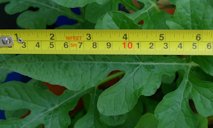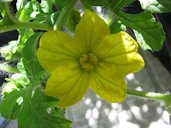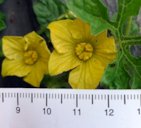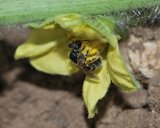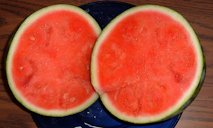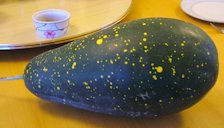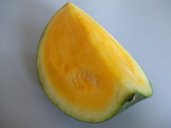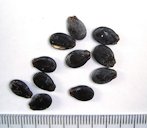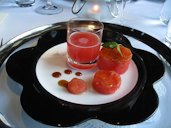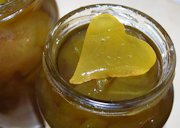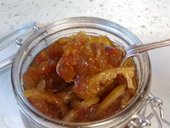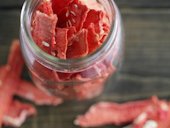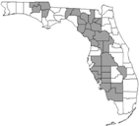| Watermelon - Citrullus lanatus | |||||||||||||||||||||||||||||||||||||||||
|---|---|---|---|---|---|---|---|---|---|---|---|---|---|---|---|---|---|---|---|---|---|---|---|---|---|---|---|---|---|---|---|---|---|---|---|---|---|---|---|---|---|
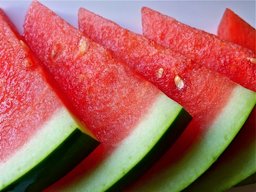 Fig. 1  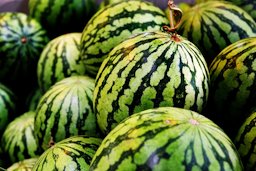 Fig. 2   Fig. 3  Seedling at Greenhouse behind old galley Sand Island, Midway Atoll, Hawai'i 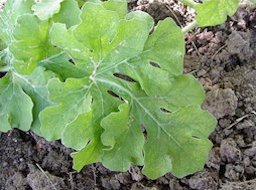 Fig. 4 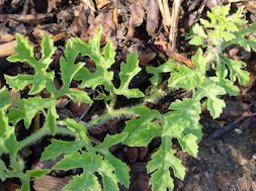 Fig. 5  Fig. 8  Flower stems of male and female watermelon blossoms, showing ovary on the female  Fig. 13  Watermelon flower and bud close up 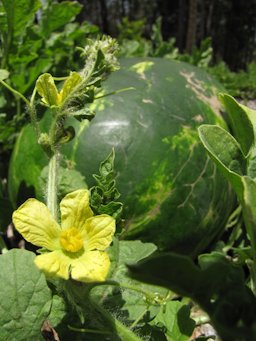 Fig. 14  Fruit and flower at Hawea Pl Olinda, Maui, Hawai'i 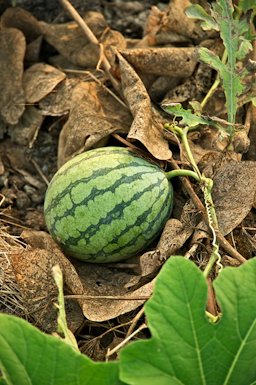 Fig. 15  Watermelon in a small-scale organic farm in Tainan City, Taiwan 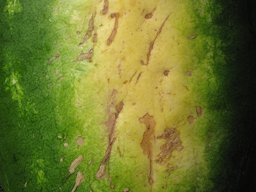 Fig. 16  Harvested fruit yellow patch on underside of melon indicating ripe at Hawea Pl Olinda, Maui, Hawai'i  Fig. 21  Watermelon mint salad 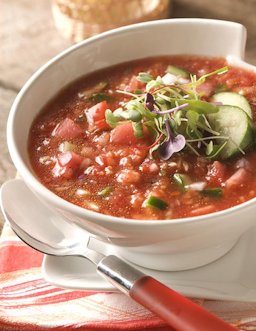 Fig. 22  Watermelon gazpacho 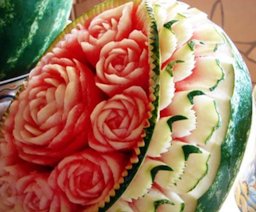 Fig. 30  Watermelon carving  Fig. 31  Watermerons for Vietnamese new year celebration. written happy word like "phát tài" (Get rich) 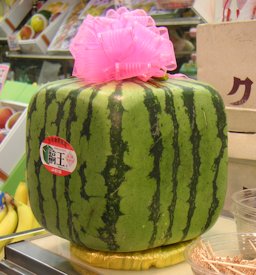 Fig. 32  Square watermelon in Japan, $300.00 (see info under General)  Fig. 33  Melons in cage, Russia 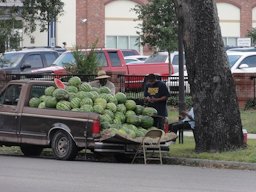 Fig. 34  Selling watermelons out of pickup truck on Davis Parkway, Mid-City New Orleans 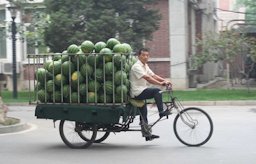 Fig. 35  Watermelon delivery running by main street of Jiaotong Daxue campus 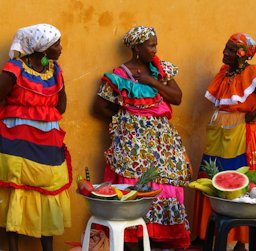 Fig. 36  Vendedoras de frutas en Cartagena de Indias, Colombia 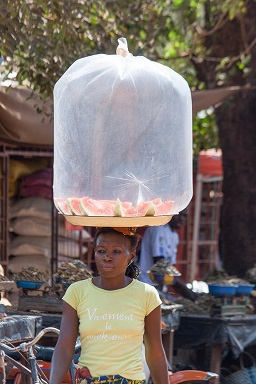 Fig. 37  Young girl selling watermelons, Burkina Faso, West Africa  Fig. 38  Emelia Rose enjoys a novel way to get all the juice from her watermelon |
Scientific
name Citrullus lanatus (Thunb.) Matsum. and Nakai Common names English: watermelon, wild watermelon, sweet melon; English, Kenya: egusi melon; French: pastèque, melon d’eau Synonyms C. lanatus (Thunb.) Matsum. and Nakai; C. lanatus (Thunb.) Mansf.; C. lanatus var. albidus (Chakrav.) Maheshw.; C. lanatus var. caffrorum (Alef.) Fosberg; C. lanatus var. capensis (Alef.) Fursa; C. lanatus var. citroides (L.H. Bailey) Mansf.; C. lanatus subsp. cordophanus Ter-Avan.; C. lanatus var. cordophanus (Ter-Avan.) Fursa; C. lanatus var. fistulosus (Steward) Babu; C. lanatus var. minor (Chakrav.) Maheshw.; C. lanatus subsp. mucosospermus Fursa; C. lanatus f. nigroseminius (Chakrav.) Maheshw.; C. lanatus var. oblongus (Chakrav.) Maheshw.; C. lanatus var. pulcherrimus (Chakrav.) Maheshw.; C. lanatus var. pumilus (Chakrav.) Maheshw.; C. lanatus var. rotundus (Chakrav.) Maheshw.; C. lanatus var. senegalicus Fursa; C. lanatus var. shami (Chakrav.) Maheshw.; C. lanatus var. variegatus (Chakrav.) Maheshw.; C. lanatus var. virgatus (Chakrav.) Maheshw.; C. lanatus var. viridis (Chakrav.) Maheshw. 8 Relatives Cucumbers (Cucumis sativus), melons (C. melo, for example), loofahs (Luffa species), pumpkins and squashes (Cucurbita species) 1 Family Cucurbitaceae (cucumber family) Origin C. lanatus is thought to be native to Africa 1 USDA hardiness zones 8a-11a Uses Eaten raw; juice; rind can be cooked Spread 10 ft (3 m) Plant habit Annual vine with long, weak, trailing or climbing stems Growth rate 80-100 days from seed; 60-90 days for transplants depending on varieties 5 Longevity Annual Leaves Deeply notched leaves, prominent veins, deep lobes; many tendrils; 'hairy' Flowers Flowers are yellow with five petals; either male or female Fruit Range in shape from oblong to round; vary greatly in size; smooth rind; juicy, sweet, red/pink/yellow flesh Season Most active harvest period from May 1 to July 1 5 USDA Nutrient Content pdf Crop Yield Only one to three fruit should be permitted to form on the vines of most cultivars Light requirement Full sun; 8-10 hours of sunlight/day 3 Soil tolerances Sandy; well drained; liberally enriched with organic matter pH preference 6.0-6.5; will tolerate 5.0 5 Drought tolerance Need regular irrigation Cold tolerance Tender, damaged by frost Plant spacing Homeowners: 6-8 ft (2.4-3.0 m); a rule of thumb is to allow 24 square feet per plant 9 Growers: Seeds are planted with 60–108 in. (152–274 cm) between rows; 24–72 in. (61–183 cm) between plants 5 Roots About 12 in. (30.4 cm) deep Invasive potential * Not a problem species (un-documented) Pest/Disease resistance Susceptible to fungal diseases and some insects and mites Known hazard None Reading Material Watermelon, Seedless, University of Florida pdf Watermelon Facts, Washington State University pdf Florida Crop/Pest Management Profile: Watermelon, University of Florida pdf Origin Watermelons are indigenous to tropical Africa, where they are found wild on both sides of the equator. They were developed from a native African vine. Their cultivation by man dates back 4,000 years to the ancient Egyptians, as proven by artistic records. Watermelons spread from ancient Egypt to India and Asia and were widely distributed throughout the remainder of the world by Africans and European colonists. 7 Originating in Africa, watermelon cultivation has a long history across the globe and even in the Americas. China has been cultivating watermelon since the tenth century and Native Americans were growing watermelon before French settlers even arrived. 13 Description The generic name Citrullus is the diminutive of Citrus, perhaps referring to the spherical fruit. The specific epithet lanatus (meaning woolly) refers to dense woolly hairs on young parts of the plants, particularly stems. 1 Watermelon is in the cucurbit family along with other melons like cantaloupe and honeydew. Winter and summer squashes, gourds, pumpkins, and of course cucumbers are also members of the cucurbit family. 13 Florida has a great climate for growing watermelon, and is actually a leading producer for the nation. While it's generally considered a summer fruit, growers in Florida are lucky enough to be able to plant watermelon for harvest in the winter as well. In fact, Florida is the only state in the country that produces watermelon from December to April. 6
Leaves Young growth is densely woolly with yellowish-brown hairs which disappear as the plant ages. The leaves are stemmed and are alternate, large and pinnately-lobed, stiff and rough when old. The plant has branching tendrils. 10
Fig. 6. Leaves measurement Fig. 7. Young hairy shoot Flowers The flowers grow singly in the leaf axils and the corolla is white or yellow inside and greenish-yellow on the underside. The flowers are unisexual, with male and female flowers occurring on the same plant (monoecious). The male flowers predominate at the beginning of the season and the female flowers, which develop later, have inferior ovaries. The styles are united into a single column and the large fruit is a kind of modified berry called a pepo. 3
Fig. 9. Female flower Fig. 10. Male flower Fig. 11. Measurement in cm Fig. 12. Lasioglossum malachurum, female foraging on a watermelon flower, Hulda, Judean Foothills, Israel Pollination Bees are essential for cucurbit production. It has been estimated that eight or more visits per blossom are necessary for optimum fruit set and normal fruit development in watermelon. The morning hours are most critical for pollination, but bees will continue to forage into the afternoon. 4 Seedless watermelon plants do not produce enough pollen for adequate fruit set and development, so they are inter- planted with seeded pollenizer watermelon plants. 5 Beekeeping: Watermelon Pollination, University of Florida pdf Fruit It has a thick rind (exocarp) and fleshy center (mesocarp and endocarp). Wild plants have fruits up to 20 cm (8 in) in diameter while cultivated varieties may exceed 60 cm (24 in). The rind of this fruit is mid- to dark green and usually mottled or striped, and the flesh contains numerous pips and is red, orange, pink, yellow, green or white. 3 Exterior color is light to dark green and may be striped or solid. Interior is white when immature, turning red, pink or yellow at maturity. 1 Depending on the cultivar, the fruit can range anywhere between 6 to 50 pounds, and in some rare instances, as much as 200 pounds. Each melon has sweet, juicy pulp that is red, pink, or even yellow. Seeds, if they exist, are black or brown; seedless varieties are also available. 6 Seedless varieties are sterile hybrids, and the seeds are produced by crossing a normal watermelon and one that was genetically changed through chemical treatment at the seedling stage. When pollinated with normal watermelon plants, seedless plants produce only small, white unde- veloped seedcoats. These are soft and tasteless and can be eaten with the watermelon flesh. 5
Fig. 17. Seedless watermelon purchased Feb. 2005 in Atlanta, GA, USA; the tag had the following information: 'Mini Me' (™) Ayaco Yaco Farms Personal seedlessWatermelon #3421 Product of Nicaragua Fig. 18. 'Moon and stars' watermelon, cultivated in Canberra, Australia Fig. 19. Watermelon (C. lanatus) with yellow flesh, bought at the Binnenrotte market in Rotterdam, the Netherlands Fig. 20. Watermelon seeds (measurement in cm) How Do They Make Seedless Watermelon? The average watermelon plant you can grow in your garden is diploid, meaning it has a complete set of chromosomes (2N). To create a seedless watermelon, a diploid watermelon plant is treated with colchicine (a plant-derived chemical) to produce a tetraploid watermelon plant that has double the normal number of chromosomes (4N). This tetraploid (4N) plant is then crossed with yet another diploid (2N) plant, which in turn produces a seed that will become a triploid (3N) watermelon plant. This triploid (3N) watermelon plant is sterile, meaning it cannot produce complete seeds. This is why you sometimes find little white "seeds" in a seedless watermelon; the "seed" is just a seed coat. 13 Varieties The more than 1200 cultivars of watermelon range in weight from less than one to more than 90 kilograms (200 lb); the flesh can be red, orange, yellow or white. 3 Seeded watermelon varieties available in Florida include, but are not limited to, ‘Estrella’, ‘Jamboree’, ‘Mardi Gras’, ‘Sangria’, ‘Sentinel’, ‘Starbrite’, ‘Stargazer’, ‘Summer Flavor 790’, ‘Summer Flavor 800’, and 'Top Gun’). 5 Seedless watermelon varieties available include, but are not limited to, ‘Affirmed’, ‘Captivation’, ‘Crunchy Red’, ‘Fascination’, ‘Joy Ride’, ‘Kingman’, ‘Melody’, ‘Sugar Fresh’, ‘Sweet Polly’, ‘TriX313’, ‘Troubadour’, and ‘7187 HQ’ (Paret et al. 2021). 5 If you're looking for something a little different, consider the heirloom variety 'Moon & Stars'. This is not your typical-looking watermelon; 'Moon & Stars' (Fig. 4) produces dark green melons that have small and large yellow dots that resemble a glowing moon surrounded by twinkling stars. 6 Harvesting Watermelons are harvested in Florida from April 1 to July 15, with the most active harvest period from May 1 to July 1. April and May’s production is primarily from southwest and west-central Florida. Growers in Central Florida begin harvesting in mid to late May, while production from north-central Florida enters the market in June (FDACS 2012; Hopkins 2003). The majority of Florida’s watermelon acreage is harvested during June (Hochmuth et al. 1997. 5 Watermelon can be harvested anytime between 70 and 90 days depending on the variety. Look for a curly tendril at the stem. The watermelon is ready to be picked when the tendril opposite the fruit stem is completely dry. Other signs of ripeness include yellowing of the underside of the fruit (Fig. 19) and a dull thump sound when tapping the fruit. 2 Unlike cantaloupes, watermelons will not continue to ripen after harvest (non-climatic). 5 Whole watermelon will stay fresh for about two weeks if it is stored at a temperature below 60 degrees F. At room temperature, it will keep for seven to 10 days. For optimum taste, place the melon in the refrigerator to cool prior to eating. Watermelon is a great, low-calorie, sweet treat with lots of nutritional value that can be enjoyed throughout the summer. 2 Propagation Watermelons can be grown either by direct seeding or by using transplants. Plant one to two seeds per pot. Cover the seeds with the soil or potting mix, and keep them in a warm place with good light. Indoors, supplemental light may be required to promote sturdy growth and prevent plants from becoming leggy. Set up lights 6 to 12 inches above the plants, and keep them on for about 14 hours a day. Be sure to keep the soil and plants moist using a fine mist. Harden the plants off before transplanting them into the garden. This can be done by leaving them outside for two or three days, but bringing them back inside each night. On the fourth day, leave them outside for 24 hours. 2 Seed to maturity requires 80–100 days, and transplanting to maturity requires 60–90 days, depending on the variety (Spreen et al. 1995). 5 Under normal conditions watermelons grown from transplants can be harvested as much as two weeks earlier than melons grown directly from seed. 9 Techniques for Melon Grafting, University of Florida pdf Vegetable Grafting: Watermelon, Washington State University pdf Healing Chamber for Grafted Vegetable Seedlings in Florida, University of Florida pdf (Archived) Planting Primary planting dates for watermelons in Florida range from December 15 to April 15. Planting extends from December 15 to March 1 in South Florida, from January 15 to March 15 in Central Florida, and from February 15 to April 15 in North Florida. 5 Growers: Seeds are planted with 60–108 inches (152–274 cm) between rows and 24–72 inches (61–183 cm) between plants, giving a plant population of 4,356 per acre at the closest spacing. Optimum yield under irrigation is generally obtained with 72–96 inches (183–244 cm) between rows and 24–48 inches (61–122 cm) between plants. Seeds are planted at a depth of 1.5–2 inches (3.8–5.1 cm). 5 Homeowners: Plant watermelon from seed in small hills with a spacing of 8 feet on all sides. Sow four to five seeds per hill at a depth of 1 inch. A week after they have germinated, thin the seedlings to two per hill. 2 Watermelon is a warm-season vegetable in the cucurbiteae family. It requires a lot of space, sunshine, water and nutrients. If you have extra room in the garden, watermelons can be fun and interesting to grow. Watermelons need a well-drained soil. The plants need plenty of room and should be kept weed free, nipping out the growing tips when the stems are two metres (yards) long. 3 Try not to disturb or move the vines as the plants grow, even to weed. If you disturb the vines, you can interrupt the flow of nutrients to the melons which increases the risk that the melons will ripen on one side, but stay green on the other side. 11
Grow the Juiciest Melons Ever, Weekend Gardener web magazine Climate Watermelons require a long, warm growing season and grow best under temperatures of 70°F–85°F (21°C–29°C), tolerating temperatures up to 90°F (32°C). The plant also tolerates high humidity (Bertelsen et al. 1994). Soil temperature also affects watermelon production. Frost easily damages seedlings, and germina- tion is very slow when the soil temperature is less than 70°F (21°C). 5 Fertilization Melons are heavy feeders and from the time they start growing until the first flower appears, melons need a steady supply of nutrients. A good formula is to mix a solution of 1 to 2 tablespoons (15 to 30 ml) of fish emulsion in 1 gallon (3.8 l) of water and apply it weekly when the plants are young. An application of a kelp-based foliar spray when the plants are in full flower will complete fertilization. 11 Nutrient Management Recommendation Series: Watermelon, University of Florida pdf Irrigation Watermelons need a lot of water. In fact, water comprises 92 percent of the watermelon fruit. Surprisingly, the bulk of watermelon roots are found in the top 12 inches of soil. Consequently when watering try and apply only as much water as the root zone (top 12”) can hold. Proper watering may require several short duration water cycles during the day. 9 Problems Poorly formed fruit can be due to several problems, the lack of pollination by bees is the most common cause. Blossom-end rot is primarily due to inadequate calcium in the plant. Too little calcium can be due to several problems which include low soil pH, low calcium and irregularly available water. To reduce blossom-end rot, maintain consistent amounts of available water in the plant root zone. All vines and little fruit are usually due to over-fertilizing with nitrogen fertilizer or planting too close. 9 Pests Page Insect pests are generally less damaging than on other cucurbits. 5 Diseases Page The most important pest groups in Florida watermelon production are disease pathogens, particularly viral diseases, and weeds. Disease pathogens are difficult to manage, and weeds have become more difficult to manage with the loss of methyl bromide. 5 Food Uses Watermelon rinds are also edible, but most people avoid eating them due to their unappealing flavor. They are used for making pickles, and sometimes used as a vegetable. The rind is stir-fried, stewed or more often pickled, and pickled watermelon rind is also sometimes eaten in the Southern US. Watermelon juice can be made into wine, on its own or blended with other fruits. An alcoholic treat called a "hard watermelon" is made by pouring liquor into a hole in the rind of a whole fruit, and then eating the alcohol-permeated flesh. 3 In China, the seeds are esteemed and eaten with other seeds at Chinese New Year celebrations. 10
Fig. 23. Watermelon agua fresca Fig. 24. The Eclipse Watermelon Martini cocktail, with vodka and watermelon; this is their house speciality I believe, and lovely it was too Fig. 25. Amuse bouche: watermelon brûlée, watermelon juice with sherry Fig. 26. Watermelon murabba (varenye, Russian for fruit preserves) Fig. 27. Watermelon and lime marmalade Fig. 28. Watermelon jerky Fig. 29. Watermelon and queso fresco salad Melons: Safe Handling Practices for Consumers, University of Florida pdf Medicinal Properties ** A study from Purdue University and University of Kentucky showed that mice fed a diet including watermelon juice had lower weight, cholesterol and arterial plaque than a control group. The findings, reported in the Journal of Nutritional Biochemistry, suggest that citrulline, a compound found in watermelon, plays a role in cardiovascular health. The National Institutes of Health, through the University of Kentucky's Center for Biomedical Excellence In Obesity and Cardiovascular Disease, funded the study. 12 General In Tokyo store space is very limited, but there are a lot of customers to sell to. The stores however, can't have round watermelons because they take up too much room, and they have too much empty space around them. No problem. They came up with the idea to grow melons inside a box, and when they're fully grown, they simply take them out of the box and can be stacked. It cuts down on transportation costs, and the grocery stores can handle them better. 11
Fig 39. Watermelon production regions in Florida Watermelons are grown throughout Florida. The greatest production region is the north to north-central region, including Levy, Gilchrist, Marion, Alachua, Hillsborough, Hendry, Suwannee, Desoto, and Hardee Counties. In 2017, this region comprised 65.2% of the harvested acreage and 39.2% of the state’s watermelon-producing farms. The south and west-central region of Florida (including Collier, Charlotte, Manatee, and Polk Counties) and Jackson County in the Florida panhandle comprised 16.9% of the acreage and 13% of the watermelon producing farms in that year. The remaining watermelon production is distributed among 53 of the state’s other counties (USDA/NASS 2021). 5 Further Reading Florida Watermelon Association ext. link Watermelon Botanical Art List of Growers and Vendors |
||||||||||||||||||||||||||||||||||||||||
| Bibliography 1 "Watermelon (Citrullus lunatus)." Plant Identification Learning Module: Vegetables, AskIFAS, edis.ifas.ufl.edu. Accessed 15 Oct. 2014. 2 Florkowaska, Malgorzata, et al. "Home Garden Watermelon." University of Georgia Extension, Dec. 2013, UGAExtension, extension.uga.edu. Accessed 14 Oct. 2014. 3 "Watermelon." Wikipedia, wikipedia.org. Accessed 15 Oct. 2014. 4 Webb, S. E. "Insect Management for Cucurbits (Cucumber, Squash, Cantaloupe, and Watermelon)." Entomology and Nematology Dept., UF/IFAS, ENY-460 (IG168), Original pub. Aug. 2001, Revised Sept. 2007, May 2010, June 2013, Feb. 2017, and July 2020, AskIFAS, edis.ifas.ufl.edu/in168. Accessed 28 July 2017, 18 Sept. 2018, 11 May 2022. 5 Elwakil, Wael M., et al. "Florida Crop/Pest Management Profile: Watermelon." Horticultural Sciences Dept., UF/IFAS Extension, CIR1236, Original pub. Oct. 1999, Revised Oct. 2000, July 2004, Aug. 2013, and July 2017, Dec. 2021, AskIFAS, doi.org/10.32473/edis-pi031-2013, edis.ifas.ufl.edu/PI031. Accessed 28 July 2017, 31 July 2019, 9 May 2022. 6 "Watermelon." Gardening Solutions, AskIFAS, gardeningsolution.ifas.ufl.edu/plants/edibles/fruits/watermelon.html. Accessed 13 June 2016, 9 May 2022. 7 Andersen, Craig R. "Home Gardening Series: Watermelons." Division of Agriculture, University of Arkansas, 2011, U of A, uaex.edu. Accessed 16 June 2016. 8 "Citrullus lanatus synonyms." The Plant List (2013), Version 1.1, www.theplantlist.org. Accessed 20 June 2016. 9 Miller, Gilbert. "Watermelons." South Carolina Cooperative Extension, Clemson University and South Carolina State University, Original pub. June 1999, Revised August 2014, clemsonedu. Accessed 20 June 2016. 10 Shiu-ying Hu. Food Plants of China. Chinese University Press, 2005. 11 Rinaldi, Hilary. "Grow The Juiciest Melons Ever." Weekend Gardener, Sept. 2013, weekendgardener.net. Accessed 15 Oct. 2014. 12 Wallheimer, Brian. "Watermelon shown to boost heart health, control weight gain in mice." Agriculture News Page, Purdue University Newsroom, 12 Oct. 2012, purdue.edu/newsroom/index. Accessed 23 June 2016. 13 "How Do They Make Seedless Watermelon?" Gardening Solutions, AskIFAS, gardeningsolutions.ifas.ufl.edu/plants/edibles/fruits/watermelon.html. Accessed 31 July 2019, 9 May 2022. Videos v1 "How to Grow Watermelons - Complete Growing Guide." MIgardener, 27 June 2015, (CC0), www.youtube.com/watch?v=X793Uy8qMcQ. Accessed 9 May 2022. v2 "Florida Watermelon Research." UF/IFAS Watermelon Research, 28 June 2021, (CC0), www.youtube.com/watch?v=T_gfYbgV1KE. Accessed 9 May Photographs Fig. 1 Farbs01. "Watermelon." Flickr, 2012, (CC BY-NC-ND 2.0), www.flickr.com. Accessed 16 June 2016. Fig. 2 ASADAL, Inc. "Watermelons, Citrullus lanatus." Commons Wikimedia, 13 Aug. 2009, (CC BY 2.0 KR), commons.wikimedia.org/wiki/File:Watermelons_3.jpg. Accessed 11 May 2022. Fig. 4,5 "Watermelons, watermelonvine and watermelon leaf." University of Florida, AskIFAS, edis.ifas.ufl.edu. Accessed 15 Oct. 2014. Fig. 3 Starr, Forest, and Kim. "Citrullus lanatus (Watermelon). Seedling at Greenhouse behind old galley Sand Island, Midway Atoll, Hawai'i." Flickr, 2008, (CC BY 2.0), www.flickr.com. Accessed 16 June 2016.VegHealingChEdis.pdfVegHealingChEdis.pdfVegHealingChEdis.pdf Fig. 6 S. L. Tan. "Watermelon leaves. Measurement in centimeter." Commons Wikimedia, 2009, (CC BY-SA 3.0), commons.wikimedia.org. Accessed 16 June 2016. Fig. 7 S. L. Tan. "Watermelon young shoot." Commons Wikimedia, 2009, (CC BY-SA 3.0), commons.wikimedia.org. Accessed 16 June 2016. Fig. 8 Pollinator. "Flower stems of male and female watermelon blossoms, showing ovary on the female." Commons Wikimedia, 2006, (CC BY-SA 3.0), commons.wikimedia.org. Accessed 16 June 2016. Fig. 9 Roberto94. "Watermelon flower female." Commons Wikimedia, 2008, (CC BY 3.0), (GFDL), commons.wikimedia.org. Accessed 15 June 2016. Fig. 10 Roberto94. "Watermelon flower male." Commons Wikimedia, 2008, (CC BY 3.0), (GFDL), commons.wikimedia.org. Accessed 15 June 2016. Fig. 11 S. L. Tan. "Watermelon neasurement in Centimeter." Commons Wikimedia, 2009, (CC BY-SA 3.0), commons.wikimedia.org. Accessed 16 June 2016. Fig. 12 Pisanty, Gideon(Gidip). Lasioglossum malachurum, female on a watermelon flower, Hulda, Judean Foothills, Israel. Commons Wikimedia, 2011, (CC BY 3.0), commons.wikimedia.org. Accessed 15 June 2016. Fig. 13 S. L. Tan. "Watermelon flower and flower bud." Commons Wikimedia, 2009, (CC BY-SA 3.0), commons.wikimedia.org. Accessed 16 June 2016. Fig. 14 Starr, Forest, and Kim. "Citrullus lanatus (Watermelon. Fruit and flower at Hawea Pl Olinda, Maui, Hawai'i." Flickr, 2012, (CC BY 2.0), www.flickr.com. Accessed 16 June 2016. Fig. 15 Hsu, Fred. "Taiwan 2009 Tainan City Organic Farm Watermelon." Commons Wikimedia, 2009, (CC BY-SA 3.0), commons.wikimedia.org. Accessed 16 June 2016. Fig. 16 Starr, Forest, and Kim. "Citrullus lanatus (Watermelon). Harvested fruit yellow patch on underside of melon indicating ripe at Hawea Pl Olinda, Maui, Hawai'i." Flickr, (CC BY 2.0), www.flickr.com. Accessed 16 June 2016. Fig. 17 Ehardt, Scott. "Seedless watermelon Purchased Feb. 2005 in Atlanta, GA, USA The tag had the following information: mini me (™) Ayaco Yaco Farms Personal seedlessWatermelon #3421 Product of Nicaragua." Commons Wikimedia, 2005, Public Domain, commons.wikimedia.org. Accessed 16 June 2016. Fig. 18 Nadiatalent. "'Moon and stars' watermelon. Cultivated in Canberra, Australia." Commons Wikimedia, 2008, (CC BY-SA 3.0), commons.wikimedia.org. Accessed 15 June 2016. Fig. 19 Hans B.~commonswiki. "Watermelon (Citrullus lanatus) with yellow flesh, bought at the Binnenrotte market in Rotterdam, The Netherlands." Commons Wikimedia, 2006, Public Domain, commons.wikimedia.org. Accessed 15 June 2016. Fig. 20 Vincentz, Frank. "Mature watermelon seeds." Commons Wikimedia, 2007, commons.wikimedia.org. Accessed 15 Oct. 2014. Fig. 21 "Watermelon Mint Salad." Foolproof Living, Foodista, 4 July 2014, (CC BY 3.0), www.foodista.com/blog/2014/07/05/watermelon-mint-salad-and-other-savory-watermelon-recipes. Accessed 10 May 2022. Fig. 22 "Watermelon Gazpacho." Picture Perfect Meals, Foodista, 4 July 2014, (CC BY 3.0), www.foodista.com/blog/2014/07/05/watermelon-mint-salad-and-other-savory-watermelon-recipes. Accessed 10 May 2022. Fig. 23 francesco_6903. "Watermelon carving." Flickr, 6 July 2006, (CC BY 2.0), www.flickr.com/photos/art_of_the_carving/344185418. Accessed 11 May 2022. Fig. 24 Joy. "Watermelon agua fresca." Commons Wikimedia, via Flickr, 27 June 2014, (CC BY 2.0), commons.wikimedia.org/wiki/File:Agua_fresca_de_sandía_(14355283017).jpg. Accessed 15 June 2016. Fig. 25 Munro, Ewan. "The Eclipse Watermelon Martini cocktail, with vodka and watermelon. This is their house speciality I believe, and lovely it was too. We had two. At Eclipse, Walton Street." Commons Wikimedia, 2011, (CC BY-SA 2.0), commons.wikimedia.org. Accessed 16 June 2016. Fig. 26 soupstance. "Amuse bouche: Watermelon brûlée, watermelon juice with sherry." Flickr, 2008, (CC BY 2.0), www.flickr.com. Accessed 16 June 2016. Fig. 27 Georgia About. "Watermelon murabba (varenye, Russian for fruit preserves)." Georgian Recipes, 2014, Commons Wikimedia, (CC BY 3.0), commons.wikimedia.org. Accessed 16 June 2016. Fig. 28 Eatwell, Jenny. ;"Watermelon and Lime Marmalade." Foodista, 15 Sept. 2015, (CC BY 3.0), www.foodista.com/recipe/C73ZRHPP/watermelon-lime-marmalade. Accessed 10 May 2022. Fig. 29 Rhiannon. "Watermelon Jerky." Foodista, 18 May2014, (CC BY 3.0), www.foodista.com/recipe/CFKZZWCB/watermelon-jerky. Accessed 10 May 2022. Fig. 30 Wood, Morgan. "Watermelon and Queso Fresco Salad." Foodista, 21 May 2015, (CC BY 3.0), www.foodista.com/recipe/KGRGSLJB/watermelon-and-queso-fresco-salad. Accessed 10 May 2022. Fig. 31 Tonbi ko. "Watermerons for Vietnamese new year celebration. written happy word like "phát tài" (Get rich)." Commons Wikimedia, 2015, (CC BY-SA 4.0), commons.wikimedia.org. Accessed 15 June 2016. Fig. 32 Laughlin. "Cubic Watermelon from Japan." Commons Wikimedia, 2005, (CC BY 2.0), Image cropped, commons.wikimedia.org. Accessed 15 Oct. 2014. Fig. 33 savage19. "Melons in cage, Russia." Commons Wikimedia, 2011, (CC BY-SA 3.0), commons.wikimedia.org. Accessed 15 June 2016. Fig. 34 Everson, Bart. "Selling watermelons out of pickup truck on Davis Parkway, Mid-City New Orleans." Commons Wikimedia, 2011, (CC BY 2.0), commons.wikimedia.org. Accessed 15 June 2016. Fig. 35 Antonini, Carla. "Watermelon delivery running by main street of Jiaotong Daxue campus." Commons Wikimedia, 2007, (CC BY-SA 3.0), commons.wikimedia.org. Accessed 15 June 2016. Fig. 36 Villa, Luz A. Vendedoras de frutas en Cartagena de Indias, Colombia. Flickr, 2008, (CC BY 2.0), www.flickr.com. Accessed 16 June 2016. Fig. 37 Rafik, Garni. "African people at work. Young girl selling watermelons, Burkina Faso, West Africa " Commons Wikimedia, 18 Nov. 2011, (CC BY-SA 4.0), commons.wikimedia.org/wiki/Category:Watermelon_vendors#/media/File:Vendeuse_de_past%C3%A8que.jpg. Accessed 1 Aug. 2019. Fig. 38 Burchett, Valerie. "Emelia Rose enjoys a novel way to get all the juice from her watermelon." Print. 16 June 2016. Fig. 39 "Watermelon production regions in Florida." University of Florida IFAS Extension, AskIFAS, edis.ifas.ufl.edu/PI031. Accessed 1 Aug. 2019. * UF/IFAS Assessment of Non-native Plants in Florida's Natural Areas ** The information provided above is not intended to be used as a guide for treatment of medical conditions using plants. Published 15 Oct. 2014 LR. Last update 6 Nov. 2024 LR |
|||||||||||||||||||||||||||||||||||||||||
